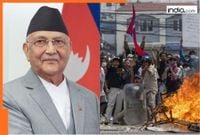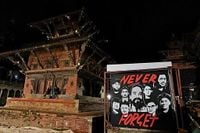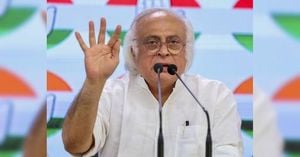On the morning of September 8, 2025, the streets of Kathmandu erupted in a way Nepal hadn’t seen for decades. What started as a youth-led protest against a government-imposed social media ban quickly spiraled into chaos. By the end of the day, 19 activists—many of them students in their school uniforms—had been shot dead outside the Parliament building in Naya Baneshwor. The next day, the violence spread, and by September 9, the death toll had climbed above 70, including three policemen. The government, led by Prime Minister KP Sharma Oli, was in crisis—its authority crumbling under the weight of public outrage and institutional collapse.
The events of those days triggered a tidal wave of demands for accountability and systemic change. On September 20, the so-called “Gen Z” group—an informal coalition of youth activists—held a press conference at Sambad Dabali, Kathmandu. Dr. Nicholas Bhusal, serving as an adviser, declared, “Oli, Lekhak, and Chief District Officer Chhabi Rijal should be arrested immediately as they were directly responsible for the shootout at Naya Baneshwor in which 19 activists were killed,” according to The Times of India. The group’s demands didn’t stop there; they also called for a high-level commission to investigate the wealth of all high-ranking leaders and government officials dating back to 1990, underscoring a broader frustration with entrenched corruption and nepotism.
The Gen Z activists staged a sit-in at Maitighar Mandala, near the Singhdurbar Secretariat—the very spot where their protest had begun on September 8. Their movement, initially a response to a government ban on 26 social media sites, had quickly evolved into a nationwide revolt against what many saw as decades of failed governance. The Oli-led government had justified the ban by citing a Supreme Court order, but on September 20, Chief Justice Prakash Man Singh Raut clarified, “The Supreme Court had not ordered the government to shut down social media sites. The apex court had urged the government to regularise the social media sites through formulating necessary laws, which is a normal international practice,” as reported by The Kathmandu Post. The ban was lifted on the night of September 8, but the damage was done—public trust in the government had evaporated.
Former Prime Minister Oli, ousted in the wake of the violence, denied any responsibility for the shootings. In his first public statement since stepping down, he insisted, “The government didn’t order to shoot at the demonstrators. The bullets were fired at the protesters from automatic guns, which were not possessed by the police personnel, and this must be investigated,” according to Republica. Oli also called for an independent probe, claiming that infiltrators had incited the violence during what he described as a “peaceful protest.” Nonetheless, his resignation on September 9—just hours after protesters stormed his office—was seen by many as an admission of political failure.
The aftermath of the protests brought Nepal to the brink. Law enforcement infrastructure was left in tatters; police stations and government buildings were vandalized, and thousands of convicts escaped from prisons across the country, including the capital. For days, there were no police on the streets—no one to record complaints, no one to stop looting or arson. Kathmandu’s historic Singha Durbar building and the health ministry office complex were set ablaze. “I never felt so insecure. For the first time, I locked all doors and windows, and kept checking after every little while whether they were alright. It was a sleepless night,” recounted Sabrina Dangol, a local resident, to Outlook India.
Amid the chaos, the search for new leadership began. Protesters in their teens and twenties, wary of political insiders, insisted that no one with ties to any political party be included in the interim government. After days of intense backchannel discussions and intergenerational dialogue, consensus formed around 73-year-old Sushila Karki, a former Chief Justice known for her fierce independence and anti-corruption stance. On September 12, Karki was sworn in as Nepal’s first woman prime minister. “She knows how the system works and can make daring decisions,” said Rajdut Karki, a 28-year-old transport worker in Kathmandu. Her first act was to declare, “Arson and vandalism during the protests are criminal acts,” promising thorough investigations and action.
But even as violence subsided, deep anxieties persisted. Senior politicians who had gone into hiding began to reappear, their futures uncertain. Oli himself, sheltered in army headquarters until September 18, continued to blame conspiracies for the killings. Meanwhile, the Hindu right-wing Rastriya Prajatantra Party (RPP) called for a restoration of the monarchy, and former Prime Minister Pushpa Kamal Dahal ‘Prachanda’ warned of efforts to destabilize the new government. “The challenge of Karki’s life,” as many Gen Z and millennial protesters put it, would be to steer Nepal through this period of conflicting interests and political intrigue.
The anatomy of the revolt reveals a generation fed up with the status quo. The government’s attempt to stifle dissent by banning social media backfired spectacularly. Young people quickly bypassed restrictions using VPNs and platforms like Discord, Facebook, TikTok, and Instagram to organize themselves. Posters calling for mass gatherings appeared across Kathmandu, and on September 8, two separate protest rallies converged at Maitighar Mandala. As the day wore on, infiltration by political cadres and organized forces became evident, with some participants destroying CCTV cameras and throwing petrol bombs. The original organizers—mostly young, nonpartisan activists—quickly distanced themselves from the violence, urging protesters to return home. But by then, the streets had been seized by other forces, including pro-monarchist groups and opportunistic criminals.
As the interim government took shape, the army played a delicate role—deploying troops, imposing curfews, and urging protesters to engage in talks. Some suspected an army coup, especially after the first post-resignation statement came from the army chief rather than the president. But the military, for its part, argued that opening fire would have led to even more bloodshed. Still, many protesters found it hard to believe that state forces had done all they could to prevent the violence and destruction.
Now, as Nepal stands at a crossroads, four main forces are jockeying for influence: the mainstream parties seeking to preserve the system and hold new elections; the RPP and other monarchists eager to see the interim government fail; Maoist factions hoping to present themselves as a socialist alternative; and independent reformers pushing for constitutional changes. Beneath it all lies a generational struggle—a youth movement determined not to let the old guard return to power unchecked. As Nayantara Gurung Kakshapati, a Kathmandu-based cultural organizer, told Outlook India, “The Nepali youth’s longing for lasting changes has reached this critical juncture not overnight, but has been building up slowly over decades.”
With an interim government committed to investigating both the violence and the roots of corruption, and with elections on the horizon, Nepal’s future remains uncertain. But one thing is clear: a new generation has made its voice heard, and the country’s old political order will never be the same.






